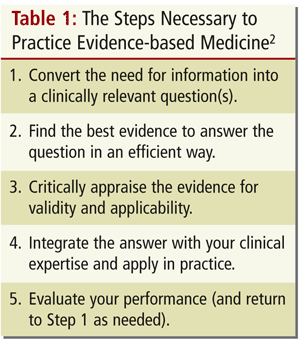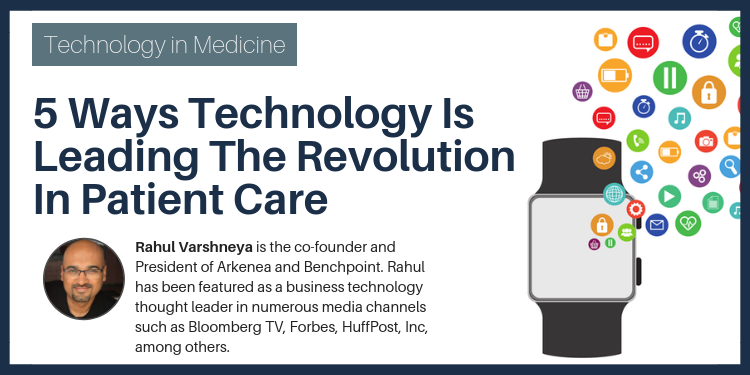D'Arcy Little, MD, CCFP, Lecturer and Academic Fellow, Department of Family and Community Medicine, University of Toronto, ON.
"The best predictor of successful guideline implementation is the provision of guideline-based recommendations that are patient specific at the time and place of the patient consultation."1
The need for relevant and timely information at the point of patient care is paramount in primary medicine. The routine care of patients necessitates having, at the clinician's fingertips, up to date information about the diagnosis, prognosis and treatment of many illnesses.2 In fact, it is estimated that two important clinical questions are generated for every three patients seen in the office.2,3 However, it is increasingly difficult to keep up to date; physicians who want to keep up with relevant journals in their field would need to review 19 articles per day, 365 days per year.2,4
The development and dissemination of clinical practice guidelines (CPGs) is one attempt to consolidate and make available information that clinicians can easily use in clinical decision-making.5 However, many guidelines may be in a format that is not user-friendly for busy daily practice.6,7 The purpose of this article is to review the role of Personal Digital Assistants (PDAs) in the implementation of CPGs, including a review of the available evidence for this practice.
 PDAs and Evidence-Based Medicine
PDAs and Evidence-Based Medicine
It is important to note that the use of PDAs does not replace any of the steps involved in practising evidence-based medicine (EBM), but it may make some of them easier. Table 1 reviews the steps devised by Straus and Sackett that are necessary to practice EBM.2 PDAs have the potential to make the best evidence available at the point of care in a fast and easily digestible format,6 thus facilitating steps 2, 3 and 4.
Barriers to Guideline Implementation
The four-stage Pathman Model has been used to delineate the barriers that exist in guideline implementation. The steps include awareness, agreement, adoption and adherence.8 For a guideline to be implemented, a physician must become aware of the guideline, then intellectually agree with it, decide to adopt it in the care he provides, and finally regularly adhere to it at appropriate times.9 Some physicians consider clinical guidelines to be akin to "cookbook medicine". As such, they balk at the idea of using decision support tools in their practice.10 PDAs may not leverage these physicians at the agreement stage; however, PDAs may have a role in the other three steps of guideline implementation.
Evidence for the Use of PDAs for Guideline Implementation
Approximately 30% of physicians now use PDAs, a number expected to increase to 50% by 2005.11 A recent systematic review of PDA use in medicine has acknowledged that despite the explosion in their use, there is a paucity of evidence-based information.12 The available evidence is discussed here.
Sackett and Straus have shown that the availability of a mobile "evidence cart"--consisting of EBM and medical reference material stored in laptops or paper inventories--in a busy inpatient medical service increased the extent to which evidence was sought and used in patient care decisions.13,14 However, the cart was found to be too bulky to take on bedside rounds. PDAs have the potential to serve as an optimally-mobile "evidence cart". Commonly used medical applications for PDAs include textbooks, rules and calculators, pharmacopoeias as well as scheduling and patient tracking programs. Recently, sites which have CPGs in PDA format also have become available ("A Brief Guide to Some Free Evidence-based Medicine Resources for the PDA" is available online at www.geriatricsandaging.ca).
Because many of the studies describing the use of PDAs in implementing guidelines are continuing, often only descriptive reports are available. There is, however, one randomized trail suggesting that the use of PDAs can enhance guideline implementation. A before-after trial with randomly selected pediatricians assessed the effect of the use of PDAs with respect to asthma guideline adherence.15
In the control and intervention phases, physicians collected data from 10 patient encounters for acute asthma. During the intervention phase, PDAs provided structured documentation and offered recommendations based on the asthma guidelines of the American Academy of Pediatrics. Patients were followed up by telephone in 7-14 days to assess outcomes. Nine physicians enrolled 91 patients in the control phase and 74 patients in the intervention phase.
The use of PDAs was found to increase physician guideline adherence. Specifically, there was more measurement of peak expiratory flows and oxygen saturation, as well as increased administration of nebulized B-2 agonists and inhaled corticosteroids.
Patients in the intervention group tended to have a greater immediate clinical improvement, but this was not the case with intermediate term outcomes, which were similar between the groups. There were no differences in patient outcomes with respect to emergency room visits, hospitalizations or missed days of school at seven days post-visit. This may have been a power issue, as the study was relatively small. In addition, the visits in the intervention group were found to be slightly longer and more costly.15
A prospective controlled pilot trial randomized family physicians to receive PDA software to help manage suspected angina or conventional care. The software consisted of an algorithm that converts the patient's demographics, risk factors and findings into the probability of having coronary artery disease, and hence directs the clinician to the appropriate investigations and treatment. The software was found to increase overall use of cardiac stress testing, with a trend toward more appropriate use of stress testing. The conclusion that PDA software may lead to improvement in the primary care management of suspected angina will be further examined in a larger trial.16,17
Conclusion
Handheld devices are gaining wide acceptance among physicians. Sites are available that literally put evidence-based medicine in the hands of physicians at the point of care. PDAs are a viable way to increase physician awareness of guidelines by allowing guideline programs to be easily downloaded and searched, and to increase physician adoption of and adherence to guidelines because the required information and reminders are close at hand and usable during patient encounters.
However, the actual guidelines that are chosen for implementation must be carefully selected. For example, several of the guideline steps in the Asthma study above, such as the administration of oxygen during an asthma exacerbation, are consensus statements without qualification of the evidence or the strength of the recommendations. All guidelines, particularly those that are to be implemented on PDAs, should be rigorously assessed with respect to their scope and purpose, stakeholder involvement, rigour of development, clarity and presentation, applicability and editorial independence.18,19 Finally, the current lack of randomized controlled evidence for guideline implementation via the PDA will likely be remedied with time, as more such studies are completed and reported.

Acknowledgements: The author wishes to thank Laure Perrier of the Knowledge Translation Program at the Faculty of Medicine, University of Toronto, for assisting in some of the literature search for this article, and Dr. Michelle Greiver for providing her abstract regarding the pilot trial of PDAs to help manage suspected angina.
References
-
Grimshaw JM, Russel IT. Effect of clinical guidelines on medical practice: a systematic review of rigourous evaluations. Lancet 1993;342:1317-22.
-
Straus SE, Sackett DL. Using research findings in clinical practice. BMJ 1998;317:339-42.
-
Covell DG, Uman GC, Manning PR. Information needs in office practice: are they being met? Ann Intern Med 1985;103:596-9.
-
Davidoff F, Haynes RB, Sackett DL, et al. Evidence-based medicine: a new journal to help doctors identify the information they need. BMJ 1995;310:1085-6.
-
Davis D, Fox R, Barnes BE. The horizon of continuing professional development: Five questions in knowledge translation. In: Davis D, Barnes BE, Fox R, editors. The Continuing Professional Development of Physicians. Chicago, IL: American Medical Association Press, 2003.
-
Rao G. Practice Corner: clinical practice guidelines and handheld computers. ACP Journal Club 2003;138:A11.
-
Lewis M. Evidence-based medicine tools for your Palm-top computer. Family Practice Management 2003;10(5).
-
Pathman DE, Konrad TR, Freed GL, et al. The awareness-to-adherence model of the steps to clinical guideline compliance. The case of pediatric vaccine recommendations. Med Care 1996;34:873-89.
-
Berg AO, Atkins D, Tierney W. Clinical practice guidelines in practice and education. J Gen Intern Med 1997;12 (Suppl 2):S25-33.
-
Schuerenberg BK. Clinical guidelines gain mobility. Health Data Management 2003;11:66.
-
Larkin M. Can handheld computers improve the quality of care? Lancet 2001;358:1438.
-
Fischer S, Steward TE, Mehta S, et al. Handheld computing in medicine. J Am Med Inform Assoc 2003;10:139-49.
-
Wilcox RA, La Tella RR. The personal digital assistant: a new medical instrument for the exchange of clinical information at the point of care. eMJA 2001;175:659-62.
-
Sackett DL, Straus SE. Finding and applying evidence during clinical rounds: the "evidence cart". JAMA 1998;280:1336-8.
-
Shiffman RN, Freudigman M, Brandt CA, et al. A guideline implementation system using handheld computers for office management of asthma: effects on adherence and patient outcomes. Pediatrics 2000;105(4 Pt 1):767-73.
-
News. FP uses PDA to ease angina diagnosis. CMAJ 2001;165:1085.
-
Greiver M. Angina on the Palm. Pilot randomized controlled trial of a new PDA-based software application for the diagnosis of suspected angina in primary care. Abstract. North American Primary Care Research Group Annual Conference (NAPCRG), Banff, AB. Oct 26, 2003.
-
Lohr KN, Field MJ. A provisional instrument for assessing clinical practice guidelines. In: Field MJ, Lohr KN, editors. Guidelines for clinical practice. From development to use. Washington D.C.: National Academy Press, 1992.
-
Cluzeau F, Littlejohns P, Grimshaw J, et al. Development and application of a generic methodology to assess the quality of clinical guidelines. Int J Quality Health Care 1999;11:21-8.


